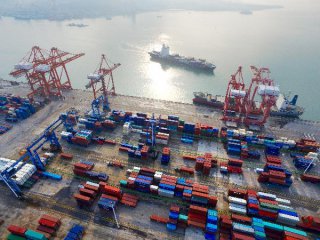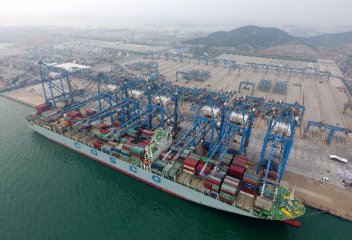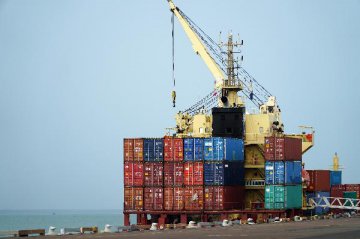
The 9th meeting of leaders from BRICS nations will be held in Xiamen city, Fujian province in September, which is expected to inject new vitality to trade of these nations. In the second half of this year, trade of China with other BRICS nations will see rapid development, and foreign trade is likely to continue to pick up and achieve positive growth over last three years. Statistics showed that China’s foreign trade grew significantly and the recovery trend was further consolidated during January and July boosted by improvement in economy and demand of trade partners.
Multi-factors drive foreign trade to recover
According statistics from the General Administration of Customs of China (GACC), China’s imports and exports recorded 15.46 trillion yuan from January to July, up 18.5 percent year on year. In breakdown, exports increased by 14.4 percent year-on-year to 8.53 trillion yuan in the same period; while imports increased by 24 percent to 6.93 trillion yuan. This led to a trade surplus of 1.6 trillion yuan, down by 14.5 percent.
“The rapid growth in China’s export is a result of multi-factors. On the whole, economy of major countries across the world all pick up, pushing up trade demand.” Lian Ping, chief economist with the Bank of Communications, pointed out that world economy has been improved greatly since this year when compared with that in the further quarter of last year. The American economy increased stably, economy of Eurozone accelerated, Japanese economy kept recovering, and that of emerging markets and China also accelerated. Meanwhile, China made remarkable progress in supply-side reform, and China’s economy bottomed out and rebounded, facilitating economy of the US and countries from European Union. In return, improvement in the US and European countries backed up China’s foreign trade, forming good interaction between internal and external demands.
“Another reason for the recovering foreign trade, which cannot be neglected, is increase in both import volume and prices of bulk commodity. Bai Guangyu, expert from Institute of International Trade, Chinese Academy of International Trade and Economic Cooperation, the Ministry of Commerce (MOFCOM), stated that import amount of crude oil, iron ore and its concentrate, coal and brown coal climbed by 50.9 percent, 50 percent and 106.2 percent in January-July period respectively, with the growth reaching peak in nearly five years. Except import volume of iron ore and its concentrate up by 7.5 percent year on year, that of crude oil, and coal and brown coal saw a double-digit growth at the same period.
“The growing foreign trade volume resulted from policy effect.” An official from Department of Foreign Trade, MOFCOM, indicated that the State Council has launched 16 policy documents promoting foreign trade development since 2013, aiming to further reduce burdens of enterprises, improve trade facilitation and accelerate transformation and upgrading of foreign trade. The 16th meeting of Leading Group on Financial and Economic Affairs required expanding imports and advancing balance of payments of current account while stabilizing export market. In addition, the MOFCOM is pushing forward optimization and construction, continues to propel pilot of new commercial types of foreign trade, promotes innovative development of processing trade and implements effective import policy, creating favorable policy environment for the sustainable and sound development of China’s foreign trade.
Trade structure is optimized continuously
While China’s foreign trade scale was expanded during January and July, structure of foreign trade experienced remarkable optimization. A batch of enterprises focus on supply-side reform, stuck to innovation-driven mode, moved quicker in adjusting structure, and focused on developing new advantage of foreign trade centering on technology, brand, quality, service and standards, which facilitates trade and investment cooperation among BRICS nations.
“Mode and structure of trade are further optimized, major trade participants are more reasonable, trade commodity structure is premium, and international markets are diversified, enabling China to establish extensive trade partnership with other BRICS nations.” Bai pointed out.
Relevant statistics showed that bilateral trade between China Pakistan reached as much as 50 billion US dollars in the first seven months of this year, up by 30.6 percent from a year earlier; China-India trade amount came at 47.5 billion US dollars, a year-on-year increase of 21.5 percent year on year; China-Russia trade amount grew by 25.5 percent year on year to 46.8 billion US dollars; and China-South Africa trade amount hiked by 26.7 percent year on year to 22.7 billion US dollars at the same period. Growth in exports to countries along the Belt and Road Route including Russia, India, Vietnam and Malaysia was higher than the year-on-year growth of China’s exports.
At the same time, the BRICS nationals convened the 7the Meeting of the BRICS Trade Ministers in Shanghai during August 1 and 2. They came to agreement on promoting trade development, intensifying cooperation on investment facilitation, deepening economic and technological cooperation and supporting multilateral trade system. These favorable factors are expected to bolster China’s foreign trade to climb in the second half of this year.
Looking into the next half of this year, Bai said that although growth in imports and exports may be slower than that in the first half, China’s foreign trade trend in 2017 will be much better than that in last two years along with global economy continuing to see stable development, internal and external demands growing and economic and trade cooperation among BRICS nations getting deepened. It will keep the growing trend as in the first half of this year and gain positive growth for the first time over last three years.
Translated By Vanessa Chen
























Latest comments